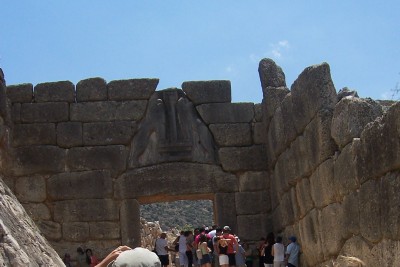|
The content on this website is
maintained by Robert
Myallis, pastor at Zion's
Lutheran Church, of Jonestown, PA.
The photos were taken by Emily
Myallis, a diaconal minister in the ELCA who also serves at
Zion's Lutheran.
This website and travel to
Greece was made possible by a grant from the
Fund for Theological Education,
which provides grants to assist the education and formation of
Christian leaders from numerous denominations.
Bible quotes are taken from the New
Revised Standard Version, unless cites otherwise.
The above photo of Greece comes from
NASA; The icon of Saint Paul comes from George Mitrevski's website. |
 |
|
Mycenae
 Mycenae,
not mentioned in the Bible, is the home to the main palace of the ancient Mycenaean civilization,
which flourished from around 1500-1100 BC. The picture is of the main
gates. The ancient Greeks believed the giant stones on the side were too
big for normal humans too have moved and hence believed that the Cyclops had
moved them. Mycenae,
not mentioned in the Bible, is the home to the main palace of the ancient Mycenaean civilization,
which flourished from around 1500-1100 BC. The picture is of the main
gates. The ancient Greeks believed the giant stones on the side were too
big for normal humans too have moved and hence believed that the Cyclops had
moved them.
Mycenae is also interesting because for many years
Homer's Iliad (where the Greeks battle Troy over Helen) was thought to be
completely fiction. However, they discovered mass amounts of gold and
masks in tombs here, perhaps giving credibility to Homer's claim that Mycenae
was rich in gold; The famous gold burial mask here is called Agamemnon's
mask after King Agamemnon, who led the Greek forces in the Battle of Troy (his
brother's wife was Helen!).
How is Mycenae significant for
understanding the world of Paul?
Besides all sorts of legends and gold, the decline of the civilization is
telling. Trade routes with cities in modern day Lebanon and Israel broke down
because of war there. This decline in revenue made it infeasible to maintain
their palace system and eventually their cities (and their writing) faded away.
It speaks to the way in which the Eastern Mediterranean, even in 1100 BC, was
interconnected.
source:
info on Mycenae: placards at archeological site and museum, July 2006.
|
|



 Mycenae,
not mentioned in the Bible, is the home to the main palace of the ancient Mycenaean civilization,
which flourished from around 1500-1100 BC. The picture is of the main
gates. The ancient Greeks believed the giant stones on the side were too
big for normal humans too have moved and hence believed that the Cyclops had
moved them.
Mycenae,
not mentioned in the Bible, is the home to the main palace of the ancient Mycenaean civilization,
which flourished from around 1500-1100 BC. The picture is of the main
gates. The ancient Greeks believed the giant stones on the side were too
big for normal humans too have moved and hence believed that the Cyclops had
moved them.